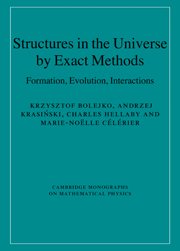
-
Select format
-
- Publisher:
- Cambridge University Press
- Publication date:
- 20 January 2010
- 22 October 2009
- ISBN:
- 9780511657405
- 9780521769143
- Dimensions:
- (247 x 174 mm)
- Weight & Pages:
- 0.62kg, 256 Pages
- Dimensions:
- Weight & Pages:
You may already have access via personal or institutional login
Book description
As the structures in our Universe are mapped out on ever larger scales, and with increasing detail, the use of inhomogeneous models is becoming an essential tool for analyzing and understanding them. This book reviews a number of important developments in the application of inhomogeneous solutions of Einstein's field equations to cosmology. It shows how inhomogeneous models can be employed to study the evolution of structures such as galaxy clusters and galaxies with central black holes, and to account for cosmological observations like supernovae dimming, the cosmic microwave background, baryon acoustic oscillations or the dependence of the Hubble parameter on redshift within classical general relativity. Whatever `dark matter' and `dark energy' turn out to be, inhomogeneities exist on many scales and need to be investigated with all appropriate methods. This book is of great value to all astrophysicists and researchers working in cosmology, from graduate students to academic researchers.
Reviews
' … it is … a necessary book, written from a general relativity point of view to study cosmological models … the book is aimed at graduate students and researchers in the fields of cosmology and relativistic astrophysics.'
Source: General Relativity and Gravitation Journal
Contents
Metrics
Altmetric attention score
Full text views
Full text views help Loading metrics...
Loading metrics...
* Views captured on Cambridge Core between #date#. This data will be updated every 24 hours.
Usage data cannot currently be displayed.
Accessibility standard: Unknown
Why this information is here
This section outlines the accessibility features of this content - including support for screen readers, full keyboard navigation and high-contrast display options. This may not be relevant for you.
Accessibility Information
Accessibility compliance for the PDF of this book is currently unknown and may be updated in the future.


